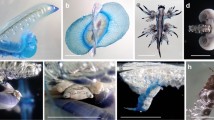Abstract
It has been hypothesized that marine fish larvae in the advanced stages of starvation would show increased density (ρ = mass volume−1) from water loss due to osmoregulation failure. Changes in larval buoyancy are currently attributed to swim bladder regulation and protein synthesis or catabolism. Osmoregulation-related changes in density is an alternative mechanism, the importance of which remains untested in the laboratory and the influence of which on vertical distributions is unknown. We provide evidence that loss of osmotic control is a plausible mechanism for increased density of larval cod (Gadus morhua L.). Furthermore, our results show that this mechanism is not restricted to larvae in the advanced stages of starvation. “Relative” larval densities are estimated using a modified density gradient. We use a gravimetric method to separate the effects of nutrition from osmoregulation failure. We assessed the importance of sampling strata on estimates of larval density. Proportional sampling within three depth strata (stratified sample) produced the least biased method for determining the “average” density of a population of larvae in laboratory culture. Larvae sampled from the bottom third of the culture tank were significantly more dense then those sampled from the surface. This was true for larvae of all ages. The average change in density from hatching till death from starvation for larvae sampled in the surface stratum was nominal (Δρ = 5.0 × 10−4 g cm−3), while the change for those sampled from the bottom stratum was large (Δρ = 3.8 × 10−3 g cm−3). These large density differences suggest that larvae sampled from the bottom stratum were either osmotically stressed or were facultatively changing their density via regulatory pathways. Preliminary observations suggest that vitality is lower amongst those larvae which are sampled near the bottom. The small change in average density of larvae sampled from the surface stratum was due to starvation. The density differences we observed between “osmotically stressed” and “starving” larvae could readily have been misconstrued as differences in feeding and growth experienced by individual larvae. The potential bias of increased density from osmoregulation failure must be considered as a factor in experimental designs developed to assess the effect of fed and starved treatments on buoyancy for larvae of all ages. The simple bioassay we describe may prove useful both as a means of assessing larval condition and as a mechanism for evaluating factors affecting larval vertical distributions in the field.
Similar content being viewed by others
Author information
Authors and Affiliations
Additional information
Received: 13 January 1997 / Accepted: 3 February 1997
Rights and permissions
About this article
Cite this article
Sclafani, M., Stirling, G. & Leggett, W. Osmoregulation, nutritional effects and buoyancy of marine larval fish: a bioassay for assessing density changes during the earliest life-history stages. Marine Biology 129, 1–9 (1997). https://doi.org/10.1007/s002270050139
Issue Date:
DOI: https://doi.org/10.1007/s002270050139




